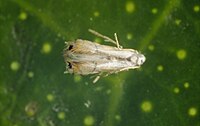
Interspecific Cross-Attraction between the South American Cerambycid Beetles Cotyclytus curvatus and Megacyllene acuta is Averted by Minor Pheromone Components
Sign Up to like & getrecommendations! Published in 2018 at "Journal of Chemical Ecology"
DOI: 10.1007/s10886-018-0933-5
Abstract: During field screening trials conducted in Brazil in 2015, adults of both sexes of the cerambycid beetles Cotyclytus curvatus (Germar) and Megacyllene acuta (Germar) (subfamily Cerambycinae, tribe Clytini) were significantly attracted to racemic 3-hydroxyhexan-2-one and… read more here.
Keywords: pheromone components; minor pheromone; attraction; pheromone ... See more keywords

Effect of (E4, Z6)-4,6-Hexadecadienal in attraction of Stathmopoda masinissa with its pheromone components of Korean population
Sign Up to like & getrecommendations! Published in 2020 at "Journal of Asia-pacific Entomology"
DOI: 10.1016/j.aspen.2020.02.003
Abstract: Abstract Timely insecticidal application for Stathmopoda masinissa Meyrick (Lepidoptera: Stathmopodidae), is important, for reducing damage to persimmon (Diospyros kaki Thunb.), an important tree fruit cultivated in Korea. In this regard, the early and precise detection… read more here.
Keywords: korean population; pheromone; stathmopoda masinissa; pheromone components ... See more keywords

Pheromone biosynthesis in bark beetles.
Sign Up to like & getrecommendations! Published in 2017 at "Current opinion in insect science"
DOI: 10.1016/j.cois.2017.09.005
Abstract: Pine bark beetles rely on aggregation pheromones to coordinate mass attacks and thus reproduce in host trees. The structural similarity between many pheromone components and those of defensive tree resin led to early suggestions that… read more here.
Keywords: pheromone components; biosynthesis bark; pheromone; pheromone biosynthesis ... See more keywords

Identifying Possible Pheromones of Cerambycid Beetles by Field Testing Known Pheromone Components in Four Widely Separated Regions of the United States
Sign Up to like & getrecommendations! Published in 2017 at "Journal of Economic Entomology"
DOI: 10.1093/jee/tox312
Abstract: Abstract The pheromone components of many cerambycid beetles appear to be broadly shared among related species, including species native to different regions of the world. This apparent conservation of pheromone structures within the family suggests… read more here.
Keywords: pheromone components; field; identifying possible; united states ... See more keywords

Identification and characterisation of female released sex pheromone components of jute semilooper, Anomis sabulifera Guenee (Lepidoptera: Noctuidae)
Sign Up to like & getrecommendations! Published in 2021 at "Journal of Environmental Biology"
DOI: 10.22438/jeb/42/2/mrn-1501
Abstract: Aim: Identification and characterization of female released sex pheromone components of jute semilooper, Anomis sabulifera Guenee (Lepidoptera: Noctuidae) from female pheromone gland extracts. Methodology: Electroantennogram (EAG) was carried for studying the antennal response; Gas Chromatography… read more here.
Keywords: pheromone components; jute semilooper; pheromone; anomis sabulifera ... See more keywords

Functional Studies of Sex Pheromone Receptors in Asian Corn Borer Ostrinia furnacalis
Sign Up to like & getrecommendations! Published in 2018 at "Frontiers in Physiology"
DOI: 10.3389/fphys.2018.00591
Abstract: Lepidopteran insects use sex pheromones for sexual communication. Pheromone receptors expressed on peripheral olfactory receptor neurons (ORNs) are critical part to detect the sex pheromones. In genus Ostrinia, several pheromone receptors were functional analyzed in… read more here.
Keywords: pheromone receptors; pheromone components; sex pheromone; pheromone ... See more keywords

Effect of Pheromone-Mediated Mating Disruption on Pest Population Density of Maruca vitrata (Fabricius) (Crambidae: Lepidoptera)
Sign Up to like & getrecommendations! Published in 2020 at "Insects"
DOI: 10.3390/insects11090558
Abstract: Simple Summary The legume pod borer is one of the most serious legume pests widely distributed in Asia, Africa, Australia, America, and Oceania. The use of synthetic pheromone lures has been developed as a more… read more here.
Keywords: maruca vitrata; disruption; pheromone components; mating disruption ... See more keywords